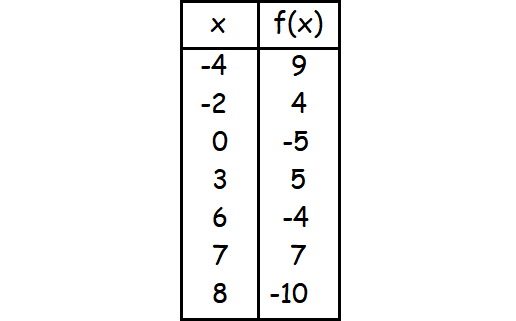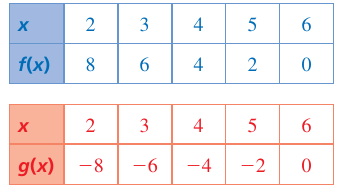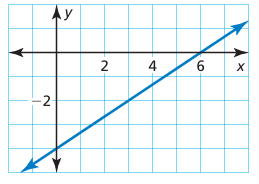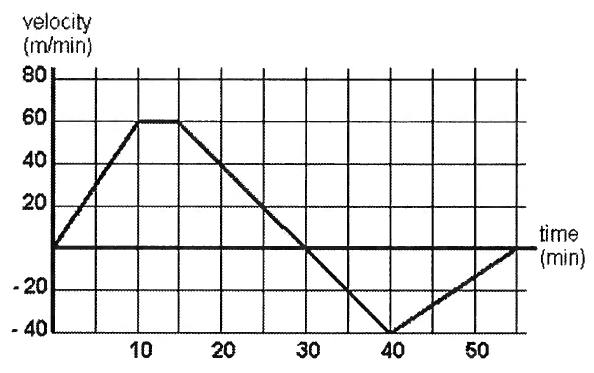FIND VALUES OF INVERSE FUNCTIONS FROM TABLES
A function is a rule that says exactly one output (f(x)- or y-value) for each input (x-value).
A function is invertible, if each possible output is produced by exactly one input. If a function f(x) is invertible, its inverse is written f-1(x).
The inverse f-1(x) takes output values of f(x) and produces input values.
That is : f-1(b) = a if and only if f(a) = b.
Example 1 :
Use the table below to find the following if possible :
(i) f -1(- 4)
(ii) f -1(6)
(iii) f -1(9)
(iv) f -1(10)
(v) f -1(-10)

Solution :
(i) f-1(-4)
a = f-1(- 4) if and only if f(a) = -4
In the above table, f(x) = -4 for x = 6.
f(6) = -4
f-1(-4) = 6
(ii) f-1(6)
a = f-1(6) if and only if 6 = f(a)
We don't find the value 6 in the column f(x).
Hence f -1(6) is undefined.
(iii) f-1(9)
c = f-1(9) if and only if f(c) = 9
In the above table, f(x) = 9 for x = -4.
f(-4) = 9
f-1(9) = -4
(iv) f-1(10)
d = f-1(10) if and only if f(d) = 10.
We don't find the value 10 in the column f(x).
Hence f-1(10) is undefined.-
(v) f-1(-10)
e = f-1(-10) if and only if f(e) = -10.
In the above table, f(x) = -10 for x = 8.
f(8) = -10
f-1(-10) = 8
Determine whether each pair of functions f and g are inverses. Explain your reasoning.
Example 2 :

Solution :
Ordered pairs of the function f(x) :
(-2, -2) (-1, 1) (0, 4) (1, 7) (2, 10)
Ordered pairs of the function g(x) :
(-2, -2) (1, -1) (4, 0) (7, 1) (10, 2)
Domain of f(x) = Range of g(x)
Range of f(x) = Domain of g(x)
So, the functions are inverse to each other.
Example 3 :

Solution :
Ordered pairs of the function f(x) :
(2, 8) (3, 6) (4, 4) (5, 2) (6, 0)
Ordered pairs of the function g(x) :
(2, -8) (3, -6) (4, -4) (5, -2) (6, 0)
Domain of f(x) ≠ Range of g(x)
Range of f(x) ≠ Domain of g(x)
So, the functions are not inverse to each other.
Example 4 :
What is the inverse of the function whose graph is shown?

a) g(x) = (3/2)x - 6 b) g(x) = (3/2)x + 6
c) g(x) = (2/3)x - 6 d) g(x) = (2/3)x + 12
Solution :
Equation of the line shown :
y-intercept = -4
Points on the line (3, -2) and (6, 0)
Slope = (y2 - y1)/(x2 - x1)
= (0 - (-2))/(6 - 3)
= (0 + 2) / 3
= 2/3
y - y1 = m(x - x1)
y - (-2) = (2/3) (x - 3)
y + 2 = (2/3) (x - 3)
y = (2/3)x - (2/3) 3 - 2
y = (2/3)x - 2 - 2
y = (2/3)x - 4
To find the inverse function,
Put y = x and x = y
x = (2/3)y - 4
Solving for y :
x + 4 = (2/3)y
y = (3/2)(x + 4)
y = (3/2) x + (3/2)(4)
y = (3/2) x + (3)2
y = (3/2) x + 6
Change y = g(x)
g(x) = (3/2) x + 6
So, option b is correct.
Example 5 :
f(x) = x/(x + 3)
a) if f-1(x) = -5, find the value of x.
b) Show that ff-1 (x) = x
Solution :
f(x) = x/(x + 3)
a)
Finding inverse :
y = x/(x + 3)
Put x = y and y = x
x = y/(y + 3)
x(y + 3) = y
xy + 3x = y
3x = y - xy
3x = y(1 - x)
3x/(1 - x) = y
f-1(x) = 3x/(1 - x)
When f-1(x) = -5
5 = 3x/(1 - x)
5(1 - x) = 3x
5 - 5x = 3x
5 = 3x + 5x
8x = 5
x = 5/8
b) ff-1 (x) = x
Applying x = 3x/(1 - x) in the function f(x) as x.
f(3x/(1 - x)) = [3x/(1 - x)]/[3x/(1 - x)) + 3]
= [3x/(1 - x)]/[3x + 3(1 - x)/(1 - x)]
= [3x/(1 - x)]/[(3x + 3 - 3x)/(1 - x)]
= [3x/(1 - x)]/[3/(1 - x)]
= [3x/(1 - x)] ⋅ [(1 - x)/3]
= x
Example 6 :
𝑓(𝑥) = 2𝑥 + 𝑐 𝑔(𝑥) = 𝑐𝑥 + 5 𝑓𝑔(𝑥) = 6𝑥 + 𝑑
𝑐 and 𝑑 are constants. Work out the value of 𝑑.
Solution :
𝑓(𝑥) = 2𝑥 + 𝑐
𝑔(𝑥) = 𝑐𝑥 + 5
𝑓𝑔(𝑥) = 6𝑥 + 𝑑
f(cx + 5) = 6x + d
2(cx + 5) = 6x + d
2cx + 10 = 6x + d
2c = 6 and d = 10
c = 3 and d = 10
Answer the following. Assume that f and g are defined for all real numbers.
Example 7 :
If f and g are inverse functions f(-2) = 3 and f(4) = -2, find g(-2)
Solution :
When f and g are inverse to each other
(-2, 3) (4, -2) are the ordered pairs of the function f, then (3, -2) and (-2, 4) are the ordered pairs of the function g.
So, the value of g(-2) is 4.
Example 8 :
If f and g are inverse functions, f(7) = 10 and f(10) = -1 find g(10)
Solution :
Ordered pairs of f are (7, 10) and (10, -1)
Ordered pairs of g are (10, 7) and (-1, 10)
Then the value of g(10) is 7.
Kindly mail your feedback to v4formath@gmail.com
We always appreciate your feedback.
©All rights reserved. onlinemath4all.com
Recent Articles
-
Digital SAT Math Problems and Solutions (Part - 150)
Apr 25, 25 11:46 AM
Digital SAT Math Problems and Solutions (Part - 150) -
AP Calculus AB Problems with Solutions (Part - 19)
Apr 24, 25 11:10 PM
AP Calculus AB Problems with Solutions (Part - 19) -
AP Calculus AB Problems with Solutions (Part - 18)
Apr 24, 25 11:06 PM
AP Calculus AB Problems with Solutions (Part - 18)
